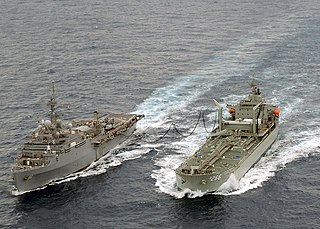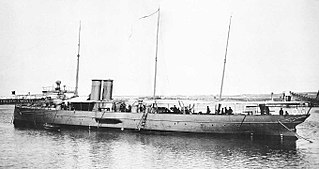
The Royal Navy (RN) is the naval warfare force of the United Kingdom, British Overseas Territories and Crown Dependencies, and a component of His Majesty's Naval Service. Although warships were used by English and Scottish kings from the early medieval period, the first major maritime engagements were fought in the Hundred Years' War against France. The modern Royal Navy traces its origins to the English Navy of the early 16th century; the oldest of the UK's armed services, it is consequently known as the Senior Service.

The Royal Australian Navy (RAN) is the naval branch of the Australian Defence Force (ADF). The professional head of the RAN is Chief of Navy (CN) Vice Admiral Mark Hammond. The Chief of Navy is also jointly responsible to the Minister for Defence (MINDEF) and the Chief of the Defence Force (CDF). The Department of Defence, which is a part of the Australian Public Service, administers the ADF, and ergo, the Royal Australian Navy. In 2023, the Surface Fleet Review was introduced to outline the future of the Navy.
Ship commissioning is the act or ceremony of placing a ship in active service and may be regarded as a particular application of the general concepts and practices of project commissioning. The term is most commonly applied to placing a warship in active duty with its country's military forces. The ceremonies involved are often rooted in centuries-old naval tradition.
The Naval Vessel Register (NVR) is the official inventory of ships and service craft in custody of or titled by the United States Navy. It contains information on ships and service craft that make up the official inventory of the Navy from the time a vessel is authorized through its life cycle and disposal. It also includes ships that have been removed from the register, but not disposed of by sale, transfer to another government, or other means. Ships and service craft disposed of prior to 1987 are not included, but are gradually being added along with other updates.

The Confederate States Navy (CSN) was the naval branch of the Confederate States Armed Forces, established by an act of the Confederate States Congress on February 21, 1861. It was responsible for Confederate naval operations during the American Civil War against the United States's Union Navy.

The Royal Canadian Navy is the naval force of Canada. The navy is one of three environmental commands within the Canadian Armed Forces. As of February 2024, the RCN operates 12 Halifax-class frigates, 12 Kingston-class coastal defence vessels, 4 Victoria-class submarines, 4 Harry DeWolf-class offshore patrol vessels, 8 Orca-class patrol vessels, and several auxiliary vessels. The RCN consists of 8,400 Regular Force and 4,100 Primary Reserve sailors, supported by 3,800 civilians. Vice-Admiral Angus Topshee is the commander of the Royal Canadian Navy and chief of the Naval Staff.
The history of the Royal Canadian Navy goes back to 1910, when the naval force was created as the Naval Service of Canada and renamed a year later by King George V. The Royal Canadian Navy (RCN) is one of the three environmental commands of the Canadian Forces. Over the course of its history, the RCN has played a role in the First World War, contributed significantly to the Battle of the Atlantic during the Second World War, and was a part of NATO's force buildup during the Cold War. In 1968, the RCN was amalgamated with the Canadian Army and the Royal Canadian Air Force to form what is today the unified Canadian Armed Forces. The naval force was known as Maritime Command until 2011, when the environmental command was renamed as the Royal Canadian Navy.

The United States Merchant Marine is an organization composed of United States civilian mariners and U.S. civilian and federally owned merchant vessels. Both the civilian mariners and the merchant vessels are managed by a combination of the government and private sectors, and engage in commerce or transportation of goods and services in and out of the navigable waters of the United States. The Merchant Marine primarily transports domestic and international cargo and passengers during peacetime, and operate and maintain deep-sea merchant ships, tugboats, towboats, ferries, dredges, excursion vessels, charter boats and other waterborne craft on the oceans, the Great Lakes, rivers, canals, harbors, and other waterways. In times of war, the Merchant Marine can be an auxiliary to the United States Navy, and can be called upon to deliver military personnel and materiel for the military.

The Military Sealift Command (MSC) is an organization that controls the replenishment and military transport ships of the United States Navy. Military Sealift Command has the responsibility for providing sealift and ocean transportation for all US military services as well as for other government agencies. It first came into existence on 9 July 1949 when the Military Sea Transportation Service (MSTS) became solely responsible for the Department of Defense's ocean transport needs. The MSTS was renamed the Military Sealift Command in 1970.
The coxswain is the person in charge of a boat, particularly its navigation and steering. The etymology of the word gives a literal meaning of "boat servant" since it comes from cock, referring to the cockboat, a type of ship's boat, and swain, an Old English term derived from the Old Norse sveinn meaning boy or servant. In 1724, a "cockswain" was defined as "An officer of a ship who takes care of the cockboat, barge or shallop, with all its furniture, and is in readiness with his crew to man the boat on all occasions." When the term "cockboat" became obsolete, the title of coxswain as the person in charge of a ship's boat remained.

A replenishment oiler or replenishment tanker is a naval auxiliary ship with fuel tanks and dry cargo holds which can supply both fuel and dry stores during underway replenishment (UNREP) at sea. Many countries have used replenishment oilers.

The Japan Maritime Self-Defense Force, abbreviated JMSDF, also simply known as the Japanese Navy, is the maritime warfare branch of the Japan Self-Defense Forces, tasked with the naval defense of Japan. The JMSDF was formed following the dissolution of the Imperial Japanese Navy (IJN) after World War II. The JMSDF has a fleet of 154 ships, 346 aircraft and 50,800 personnel.

A sea captain, ship's captain, captain, master, or shipmaster, is a high-grade licensed mariner who holds ultimate command and responsibility of a merchant vessel. The captain is responsible for the safe and efficient operation of the ship, including its seaworthiness, safety and security, cargo operations, navigation, crew management, and legal compliance, and for the persons and cargo on board.

Destructor was a 19th-century Spanish warship. She was a fast ocean-going torpedo gunboat and the main precursor of the destroyer type of vessel. Destructor was the first warship classified as a "destroyer" at the time of her commissioning. Her designer was a Spanish Navy officer, Fernando Villaamil, commissioned by the Minister of the Navy, Vice-Admiral Manuel Pezuela.

USS Regulus (AF-57) was a Denebola-class stores ship acquired by the United States Navy. Her task was to carry stores, refrigerated items, and equipment to ships in the fleet, and to remote stations and staging areas.

The United States Navy (USN) is the maritime service branch of the United States Armed Forces and one of the eight uniformed services of the United States. It is the world's most powerful navy and the largest by displacement, at 4.5 million tons in 2021. It has the world's largest aircraft carrier fleet, with 11 in service, one undergoing trials, two new carriers under construction, and six other carriers planned as of 2024. With 336,978 personnel on active duty and 101,583 in the Ready Reserve, the U.S. Navy is the third largest of the United States military service branches in terms of personnel. It has 299 deployable combat vessels and about 4,012 operational aircraft as of July 18, 2023.
Rear admiral (RAdm) is a flag officer rank of the Royal Navy. It is immediately superior to commodore and is subordinate to vice admiral. It is a two-star rank and has a NATO ranking code of OF-7.

The SS Baton Rouge was a cargo Victory ship built during World War II under the Emergency Shipbuilding program. The Baton Rouge (MCV-846) was a type VC2-S-AP2 Victory ship built by Bethlehem-Fairfield Shipyards. The Maritime Administration cargo ship was the 846rd ship built. Her keel was laid on June 21, 1945. She was launched on August 22, 1945, and completed on September 24, 1945. The 10,600-ton ship was constructed for the Maritime Commission. The American Export Line and later the Isthmian Steamship Company operated her under the United States Merchant Marine act for the War Shipping Administration.

The Admiral of the Narrow Seas also known as the Admiral for the guard of the Narrow Seas was a senior Royal Navy appointment. The post holder was chiefly responsible for the command of the English navy's Narrow Seas Squadron also known as the Eastern Squadron that operated in the two seas which lay between England and Kingdom of France and England and the Spanish Netherlands later the Dutch Republic from 1412 to 1688. His subordinate units, establishments, and staff were sometimes informally known as the Command of the Narrow Seas.

The SS Alamo Victory was the 42nd Victory ship built during World War II under the Emergency Shipbuilding program. She was launched by the California Shipbuilding Company on July 13, 1944, and completed on August 18, 1944. The ship’s United States Maritime Commission designation was VC2- S- AP3, hull number 42 (V-32), she worked as merchant marine for all of her career. SS Alamo Victory served in the Pacific Ocean during World War II and was operated by the Isthmian Steamship Company. The 10,500-ton Victory ships were designed to replace the earlier Liberty Ships. Liberty ships were designed to be used just for World War II. Victory ships were designed to last longer and serve the US Navy after the war. The Victory ship differed from a Liberty ship in that they were: faster, longer and wider, taller, had a thinner stack set farther toward the superstructure, and had a long raised forecastle.














